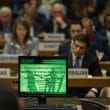The bioweapons threat is broader and closer than commonly thought
By Jonathan B. Tucker, March 26, 2008
I don't disagree with most of my colleagues' points, particularly with respect to the debate over the use of incapacitating chemicals for law enforcement purposes. I differ slightly, however, with Pal Aas's contention that any bioterrorist threat associated with the misuse of bioregulators lies in the distant future.
For the near term, it's clear that the primary risk lies with states seeking novel incapacitating agents for counterterrorism operations. Looking ahead 10 or 20 years, however, one cannot be confident that terrorists will stick to guns, explosives, and "classical" agents such as Sarin or anthrax. Given the global diffusion of biotechnology, it seems likely that these capabilities will trickle down to extremist groups and brilliant but sociopathic loners such as the Unabomber. Indeed, the current preoccupation with "dual-use research of concern" in the life sciences is based on the belief that terrorists will eventually exploit cutting-edge advances for hostile purposes.
Take the case of synthetic genomics. Within the past decade, the advent of automated, high-throughput DNA synthesizers has made it possible to synthesize genes and even entire genomes from scratch. Since 2002, molecular biologists have assembled the genomes of three functional viruses in the laboratory–poliovirus, the phiX174 bacteriophage (a virus that is parasitic on bacteria), and the 1918 pandemic strain of the influenza virus. In January 2008, researchers at the J. Craig Venter Institute in Rockville, Maryland, announced that they had synthesized a simplified version of the genome of the bacterium Mycoplasma genitalium containing all of the genes needed to sustain independent life. This "minimal genome," made up of 582,970 DNA base pairs, is 10 times larger than any piece of DNA previously synthesized.
These remarkable achievements have resulted in a shift from materials-based risks to knowledge-based risks. High-throughput synthesizers can rapidly convert a DNA sequence stored in computer memory into the physical reality of a pathogenic gene or an infectious virus. Moreover, companies that synthesize custom pieces of DNA to order for corporate or scientific clients are springing up around the world, even in cities such as Beijing, Mumbai, and Tehran. Some of these firms, called "gene foundries," are capable of making gene-length DNA strands that can be ordered over the Internet. Access to this capability could eventually enable technically skilled individuals to construct deadly viruses such as Ebola in the laboratory, circumventing governmental controls on "select agents" of bioterrorism concern.
Given the existence today of thousands of "black-hatted" software hackers who create and disseminate destructive computer viruses for their own personal gratification, it does not seem far-fetched to worry about the possible emergence of a new generation of hobbyists or "biohackers" who exploit biotechnology for malicious purposes. The pool of individuals with relevant technical know-how is expanding rapidly as the field of synthetic biology attracts established researchers, graduate students, and even undergraduates. For example, MIT sponsors an annual International Genetically Engineered Machines competition in which student teams manipulate advanced genetic components and technologies. This event has grown from five teams in 2004 to 54 teams (750 students) from 19 countries in 2007.
Although scientists and engineers tend to be skeptics who are not usually attracted to religious cults or extremist groups, there are exceptions to this rule. During the 1990s, for example, the Japanese doomsday cult Aum Shinrikyo successfully recruited university-trained chemists and biologists, suggesting that smart but alienated people suffering from a spiritual vacuum in their lives may be susceptible to a charismatic leader who provides a sense of meaning and belonging. Motivations for a scientist to develop an advanced bioweapon could be religious, ideological, or strictly personal, such as a bitter grudge against a former employer or an ex-lover.
An unknown variable is the skill set needed to carry out a high-end bioterrorist attack. Kathleen Vogel of Cornell University has argued that in addition to "explicit knowledge," such as recipes for producing and formulating pathogens or toxins, a bioterrorist would have to acquire two types of "tacit knowledge" that cannot be reduced to writing. Personal tacit knowledge refers to hands-on laboratory skills developed by working with biological agents and specialized equipment, while communal tacit knowledge derives from close working relationships with specialists from various disciplines. According to Vogel, such knowledge can be acquired through person-to-person transfer ("learning by example") and trial-and-error problem-solving ("learning by doing").
The need for tacit as well as explicit knowledge to weaponize and deliver biowarfare agents may limit the ability of ordinary scientists to exploit advanced biotechnology for hostile ends, reducing the risk of high-end bioterrorism. Given current technological trends, however, it would be unwise to rule it out entirely.
Topics: Biosecurity
Share: [addthis tool="addthis_inline_share_toolbox"]














